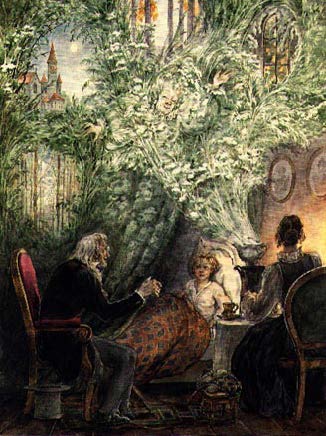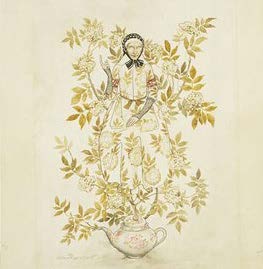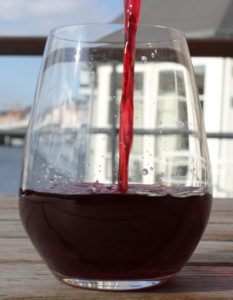by Justine de Valicourt
Overview
Investigating hydrogen cyanide was a gateway to full-fledged elder-obsession. This post explores the complexity of Sambucus nigra, the elderberry tree, in folklore and throughout its traditional and modern uses in woodcraft, horticulture, medicine, and cuisine.
The plant is considered toxic, but the poisonous alkaloids and glycosides are contained mostly in the bark, leaves and stems. Most scientific literature considers the ripe berries safe when consumed in moderate quantities. However, we tested raw elderberry juice on the lab team and all of us except one felt very nauseous for the few minutes after ingestion. We still don’t fully understand the causal mechanism for this effect, so we recommend to gently heat or ferment the fruits/juice before consuming. The flavour is much improved with acidity, which fermentation (kombucha and vinegar, for example) seems to be a good way to achieve.
Can someone fall in love with a plant? Dan Barber fell in love with a fish, Roland Rittman with a piece of wilderness. Well I have fallen for elder. Sambucus nigra has spread its roots throughout human culture: history, folklore, music, woodcraft, horticulture, medicines traditional and modern, beverages and cuisine. And on top of all this knowledge, elder offers generous amounts of fragrant beautiful flowers and rich dark fruits. What more can one ask from a beloved?
Folklore
Hyldemor is part of Danish folklore and the basis for Hans Christian Anderson’s story The Little Elder-Tree Mother (1845). She is the elder-mother, the spirit of the tree. One says that you should always ask her permission before cutting elder wood, and if you don’t, she may take revenge and haunt the new object (be careful if it is a cradle). Some superstitions say that if you burn elder, you will bring the devil into your house; others that if you plant an elder near your door, you will protect your house from him (Grieve, 1931; Wikipedia).


In Denmark, one should not sleep under an elder at midsummer because one might see the Fairy-king and all his retinue; in Scotland, the same situation may happen on All Hallows Night (Halloween). Though it could be fun to meet them, sleeping under the tree still seems not recommended.
Medieval belief had it both the tree from which Judas hanged himself and the wood of the Cross of Cavalry, elevating it to a potent emblem of death and sorrow. (Grieve, 1931)
And thanks to J.K. Rowling, elder is also known to be the wood of the most powerful wand ever made.
That is a lot of beliefs for such a common shrub!
Woodcraft
Sambucus nigra has hard wood but hollow stems and has been used to make flutes, pipes, pop-guns, combs, pegs and other small items
(Stevens, 2010). The common name might come from Æld, ‘fire’in old English, because of the use of the young hollow branches to blow on a timid fire. The Latin name seems to come from a musical instrument made from its wood, called a sambuca (Grieve, 1931). Historical records are not clear if it was a string or a wind instrument (Grieve, 1931; Wikipedia).
Horticulture
The leaves and bark are full of cyanogenic glucosides and volatile neurotoxic alkaloids: sambugrine and conicine. This could be the reason one meets the king of Elves after sleeping under the elder tree. When crushed and infused in water, the leaves can be very effective as an
insecticide and insect repellant (PFAF; Grieve, 1931). However, as the leaves’ narcotic odour would also be transferred to the skin, it might also repel more humane companions.
The foliage also has a high decomposition rate compared with most plants, making it a great compost enhancer. This same effect can be achieved if the roots spread close to the compost (Atkinson, 2002; PFAF). Definitely a good shrub to keep in the garden.
Medical uses
Traditionally, the flowers, berries, bark, and leaves have been used in homemade remedies against more or less everything. It used to be the panacea of natural medicine, curing influenza, cold, cough, bronchitis, sore throat, headache, asthma, malaria, scarlet fever, measles, syphilis, other fever and eruptive diseases, bruises, inflammation, freckles and sunburns, chapped hands, chilblains, erysipelas, rheumatisms, blood circulation deficiencies, and sciatica. It was used to promote all ‘natural secretions by stool, urine and sweat’, and even to dye hair black (Grieve, 1931; Meiers, 2001). Its effectiveness against measles, syphilis, scarlet fever and freckles hasn’t been proven, but some recent research has documented the berries’ inhibitory effect of 11 strains of influenza as well as their capacity to stimulate cytokine production (Charlebois, 2007; Barak, 2001). Cytokines are cell messengers of the immune system, enhancing the organism’s reaction to an infection. They also contain more antioxidants than most other small berries, most of them in the form of cyanidin, an anthocyanin that was found to be an effective inhibitor of human tumour cells in vitro (Meiers, 2001). They also contain great amounts of iron, phosphorous, and vitamins A and C (Charlebois, 2007).
To eat or not to eat?
The leaves and bark contain a lot of the cyanogenic glycoside sambunigrin (0.16% of leaf weight) (Grieve, 1931) and the alkaloids sambucine and conicine. These three components are poisonous in small doses.
We began investigating cyanide poisoning in the previous post ‘Searching for cyanide’. From the figure stated above we can estimate a concentration of 1600mg per kg of leaves, which means that if we go with the lowest documented lethal dose of 37.8mg of HCN, the consumption of 23.6g of leaves can be life-threatening (even without considering the presence of conicine, the same poisonous alkaloid in hemlock).
It thus makes sense that the bark and leaves have been used in small doses as purgatives and emetics, as well as expectorants, diuretics, and diaphoretics. These last two properties made them useful in the treatment of oedema. Considering their toxicity, however, one should certainly consider other more modern and effective treatments instead of such a potential poison.
Which brings us back to the berries. They are considered safe to eat by many sources as long as they are totally ripe (Charlebois, 2007; EMeA, 2013; Stevens, 2010; PFAF). The cyanogenic, lectin, and alkaloid contents can be harmful when the berries are not completely purple-black. Raw preparations should be done carefully without any stems or leaves. Some cases of food poisoning have been scientifically documented in the last fifty years, but all of them were due to unripe berries or preparations made from berries with leaves and stems. One of them occurred in 1984 from a juice made from raw berries with their leaves and stems (Kunitz, 1984). One of the 8 people treated drank 5 glasses of juice in a very short time and had to be hospitalised overnight for the stuporous state it induced. The others experimented nausea, vomiting, abdominal cramps and weakness. All recovered quickly.
The European Food Safety Authority (2012) published data stating the presence of cyanogenic glycosides in the berries to be up to 3mg/100g of fruits. No information was included about the ripeness of the berries used to evaluate this concentration.
All this information brings us to the conclusion that if you are planning to eat more than 1.2kg of berries in one day, you might want to cook them. If you want to eat less than 1.2kg raw, you should make sure that no leaves, bark, or stems are included in the preparation. The tannins and viburnic acid contained in the fruits might have a high effect at this dose. They normally treat irregular bowel movement and nasal and bronchial congestion (Charlebois, 2007), but we could not find any information about their effect at higher doses.
However safe on paper the berries may be to eat, we decided to use ourselves as Guinea pigs and test the effect, or non-effect, of drinking raw fresh juice. The results are beguiling: 5 of the 6 of us experienced strong nausea after drinking only a few milliliters; nobody was properly sick, but most of us felt unpleasant for around 15 minutes. Some also experienced revulsion even at the idea of drinking more. In other words, however, appealing elder may be, one should not offer the raw juice on a first date (but it could be a fun activity for the second or third).
We already know that cooking renders them safe, but it was also interesting to notice that none of the ill effects were present after consuming the fermented juice. We still have more research to do to understand what causes this nausea/revulsion, and why it affected only 5 out of 6 testers (the only seemingly immune one being Josh; also the only male subject, but this is probably a coincidence).
Heat, acid, fermentation
Traditionally, elderberries have been used in food and beverages to make wine, preserves and medicinal syrup, and to adulterate port wine. This practise was so common that old dark-red port was considered a good remedy against rheumatisms, until further investigation revealed the fact that true aged port had almost no anti-neuralgic effects, while in fact it was only the cheap, fake-aged port made from a large proportion of elderberry wine (Grieve, 1931).

In most parts of Europe the use of the flowers in cooking and beverages is mostly limited to elderflower lemonade, cordial, wine, sparkling wine, and fritters, while some also make them into jam. A couple of breweries have used them in beer, mainly in the United States and England. In our research, we found few references to elderberry beer.
However fantastic, loveable and rich in potential the shrub may be, the fruit itself can be disappointing. Their taste is boringly balanced and flat, and their aroma when raw is reminiscent of rotten flowers, bitter green leaves, grass, or rubber. (not great!) while their flavours bring more notes of leaves, wood, sometimes moss and paint. However, heat and a pinch of acid (traditionally lemons and/or citric acid) reveal more of their floral notes.
We also consider fermentation a great option to enhance their complexity – we have developed an elderberry kombucha, and are working on a longer-term, multi-stage
elderberry and elderflower vinegar. The high levels of tannins and anti-oxidants give it great aging potential, yet a further sign that the fruit is simply meant to be fermented.
Now that our vinegar is in its second fermentation, more kombucha is acidifying and our freezer is still full of berries, we will be able to test many recipes to reduce the mossy and rotten aromas and reveal the fresh, flowery, and fruity ones. Then, maybe we will discover another side of elderberries and fall in love with this complex plant utterly and for real.
References
ANDERSON, H.C. The Little Elder-Tree Mother. 1845. Consulted online on September 10, 2013.
<http://hca.gilead.org.il/li_elder.html>
ATKINSON, Mark D. and ATKINSON, Elaine. Sambucus nigra L. Journal of ecology, 2002, vol. 90,
no 5, p. 895-923.
BARAK, Vivian, HALPERIN, Tal, et KALICKMAN, Inna. The effect of Sambucol, a black elderberry-based, natural product, on the production of human cytokines: I. Inflammatory cytokines. Eur Cytokine Netw, 2001, vol. 12, no 2, p. 290-296.
CHARLEBOIS, D. Elderberry as a medicinal plat. Issues in new crops and new uses. ASHS, Alexandria, VA. 2007. p. 284-292.
EUROPEAN MEDECINE AGENCY (EMeA). Committee on Herbal Medicinal Products (HMPC). Sambucus nigra L., flos. Assessment report for the development of community
monographs and for inclusion of herbal substance(s), preparation(s) or combinations therof in the list. London, July 2008. Doc. Ref. EMEA/HMPC/283170/2007.
EUROPEAN FOOD SAFETY AUTORITY (EFSA). Compendium of botanicals reported to contain naturally occuring substances of possible concern for human health when used in food and food supplements. In EFSA Journal 2012. Vol10. Issue 5. p.2663.
GRIEVE, M. Elder, Botanical.com—A modern Herbal. Online. <http://botanical.com/botanical/mgmh/e/elder-04.html> 1931. Consulted on August 29, 2013
KUNITZ, S. Poisoning from Elderberry juice. California Morbidity (February 24, 1984). Reported in Morbidity and Mortality Weekly Report (MMWR). April 6, 1984. Vol 33. Issue 13. p.173-4. Online. <http://www.cdc.gov/mmwr/preview/mmwrhtml/00000311.htm>
MEIERS, S., M. Kemeny, and all. The anthocyanidins cyanidin and delphinidin are potent inhibitors of the epidermal growth-factor receptor. Journal of Agriculture and Food Chemistry, 2001, vol.49, p. 958-962.
PLANTS FOR A FUTURE (PFAF). Sambucus nigra L. Web. <http://www.pfaf.org/user/Plant.aspx?LatinName=Sambucus+nigra> August 28, 2013
STEVENS, M. Plant Guide for common elderberry (Sambucus nigra L. ssp. Canadensis (L.)) R. Bolli.USDA-National Resources Conservation Service, National Plant Data Center, Baton Rouge, LA. 2001. Last edition 2010.
WIKIPEDIA. Sambucus. Consulted on September 10, 2013. <http://en.wikipedia.org/wiki/Sambucus>
